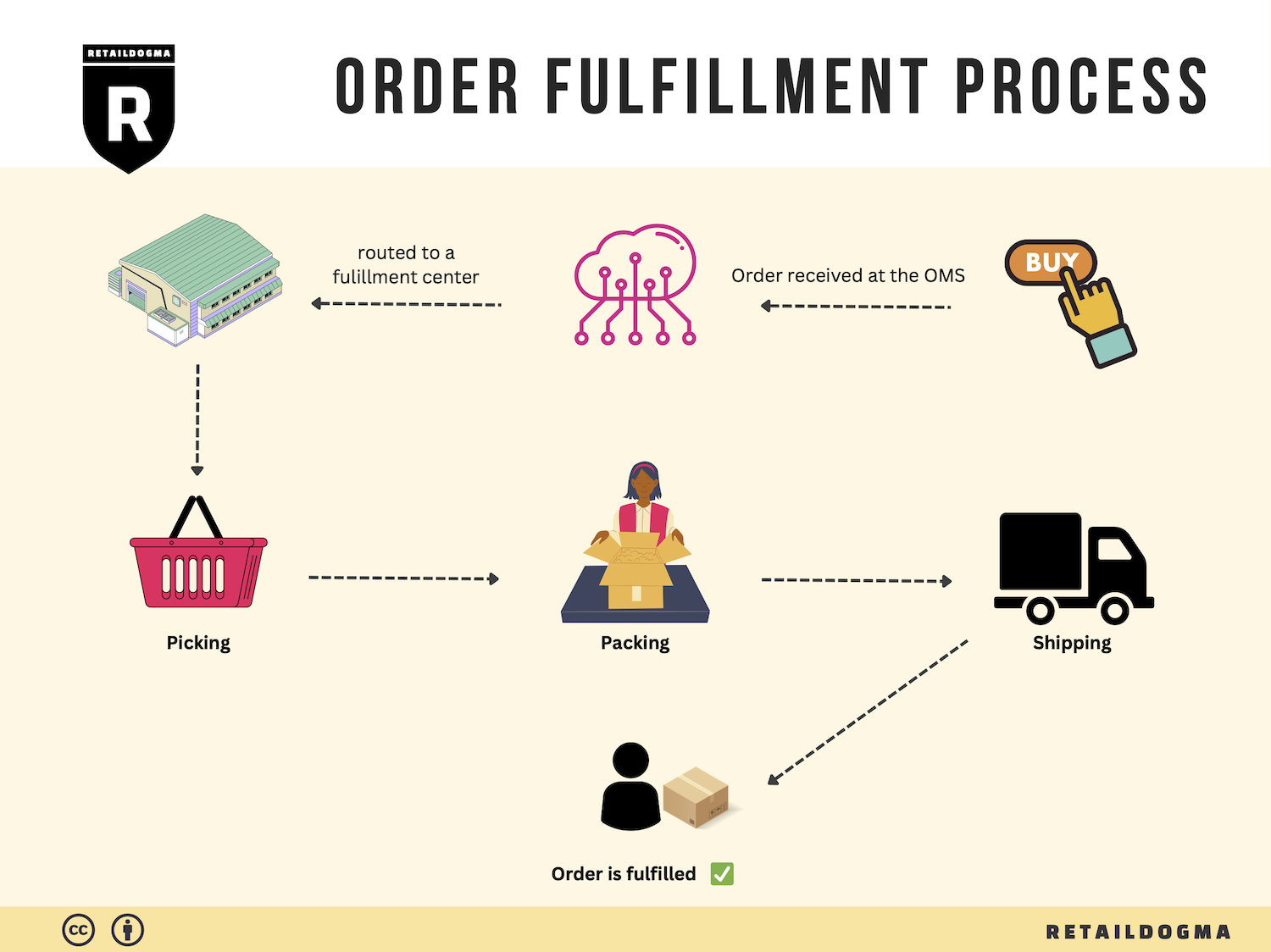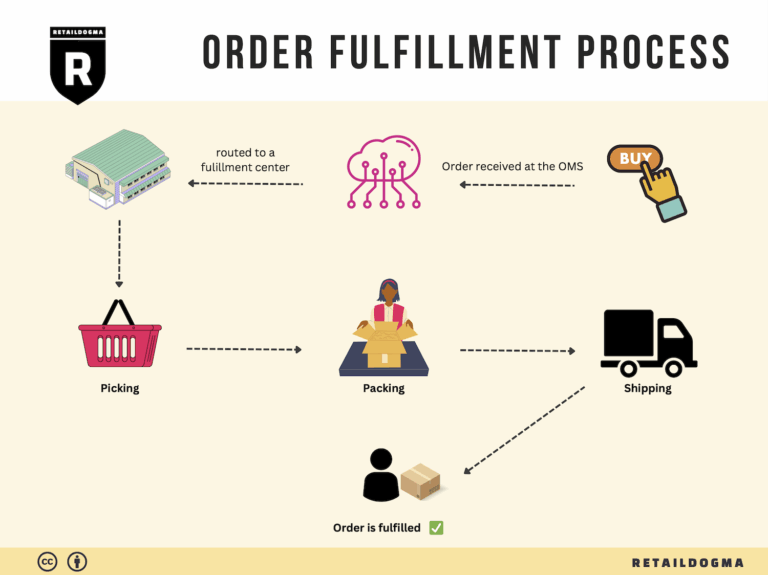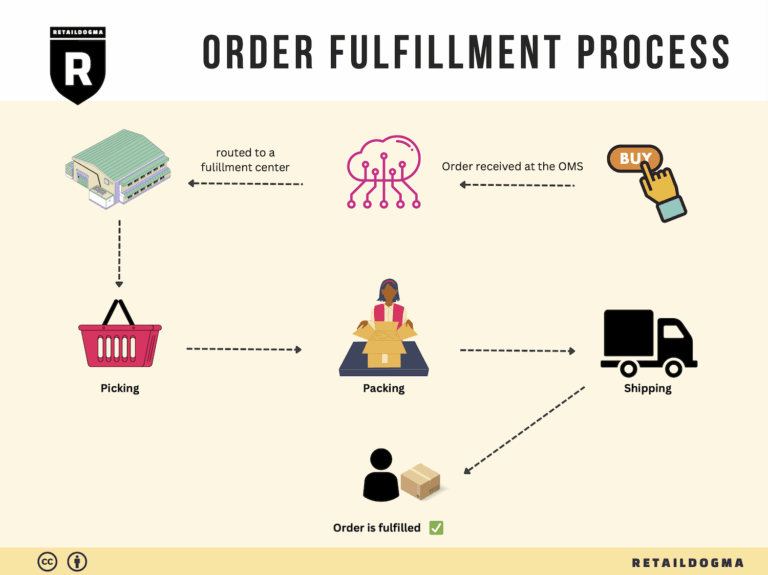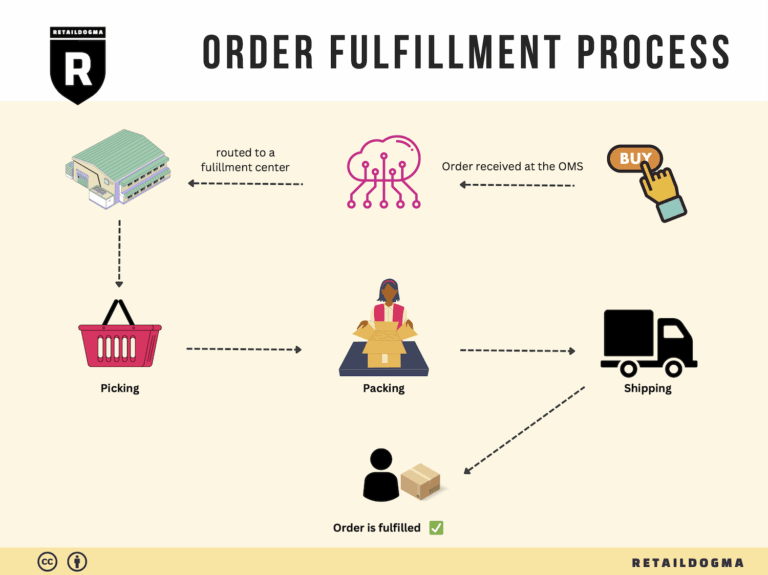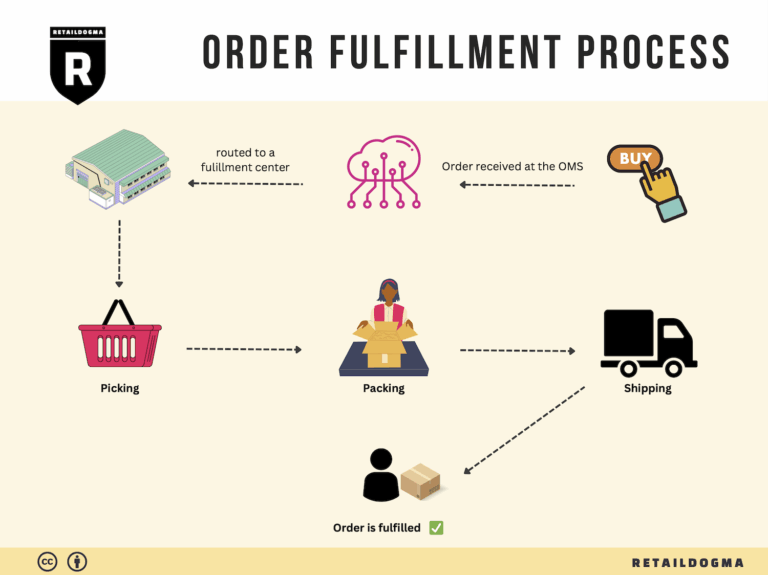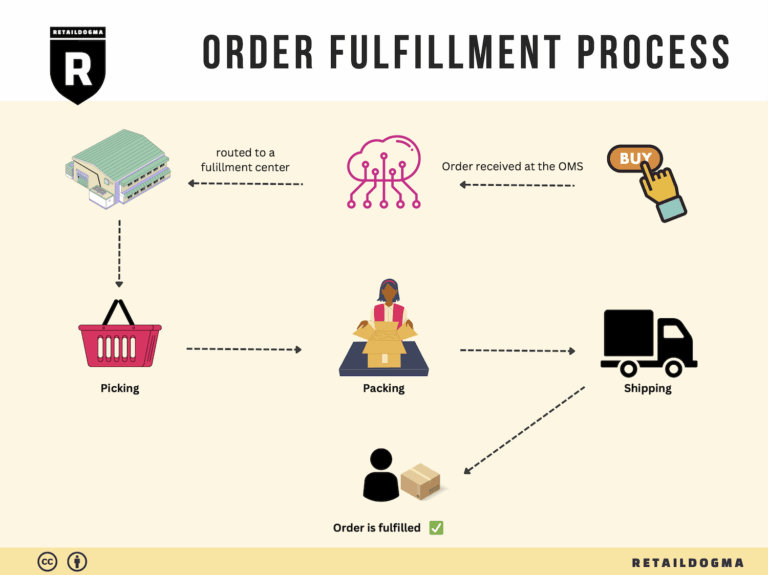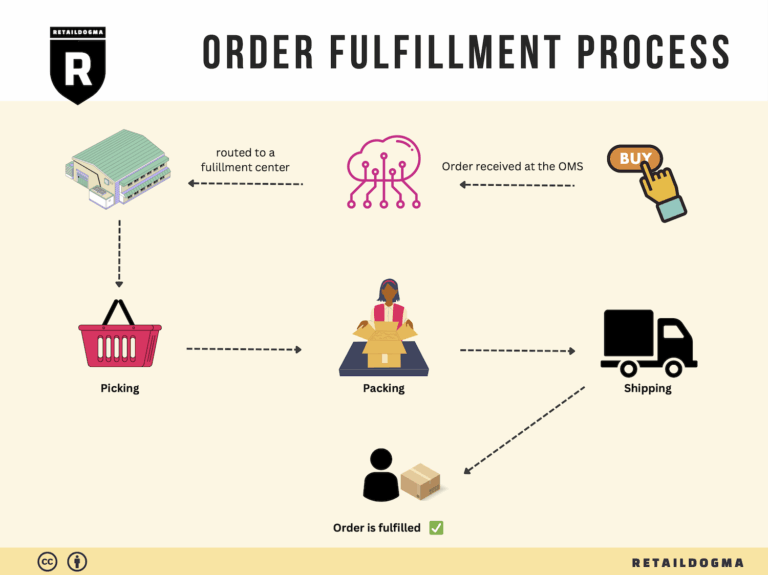How Order Fulfillment Works: A Step-by-Step Guide for Businesses
What is E-commerce Fulfillment? An Introduction for Growing Businesses
Understanding E-commerce Fulfillment for Growing Businesses
As an e-commerce business owner, you may find yourself grappling with the challenges of packing and shipping orders efficiently. The excitement of making sales can quickly turn into a logistical nightmare if you are overwhelmed by the fulfillment process. Effective fulfillment is crucial for maintaining customer satisfaction and ensuring your business scales smoothly. Simply put, fulfillment is the entire process of getting a product from your inventory to your customer’s doorstep. This includes everything from order processing to shipping and handling returns.
In this guide, we will explore various fulfillment models that can streamline your operations and help you focus on growth. You’ll learn about Third-Party Logistics (3PL) providers, Fulfillment by Amazon (FBA), and other fulfillment strategies that can fit your business needs. Each model has its unique advantages and challenges, and understanding these can empower you to make informed choices.
We will also cover the core services involved in fulfillment, including order processing, inventory management, shipping logistics, and returns handling. These services are essential for maintaining a smooth operation, and knowing what to expect can help you choose the right fulfillment partner.
Choosing a fulfillment partner is one of the most critical decisions you’ll make as a growing business. We’ll provide practical advice on what to look for in a partner, including their expertise, speed of service, and the ability to scale with your business. Transparency in pricing and operations is another vital factor that will be discussed, ensuring you find a partner who aligns with your values and goals.
Finally, this guide aims to empower you to make smart decisions regarding your logistics. By understanding the landscape of e-commerce fulfillment, you can select the best strategies and partners that will not only meet your current demands but also support your future growth. With the right fulfillment approach, you can turn the burden of logistics into a competitive advantage, allowing you to focus on what you do best: growing your business.
What You’ll Learn In This Guide
- What is E-commerce Fulfillment? An Introduction for Growing Businesses
- The Order Fulfillment Process: From ‘Buy’ Button to Customer’s Door
- Comparing Fulfillment Models: In-House vs. 3PL vs. Dropshipping
- A Deep Dive into Amazon FBA: Pros, Cons, and Who It’s For
- Core Services Offered by Fulfillment Centers
- How to Choose a Fulfillment Partner: A 6-Point Checklist
- Understanding Fulfillment Pricing: A Breakdown of Common Fees
- Frequently Asked Questions (FAQs) about Fulfillment
- Conclusion: Is Outsourcing Fulfillment the Right Move for Your Business?
- Important Disclaimer
The Order Fulfillment Process: From ‘Buy’ Button to Customer’s Door
1. Receiving Inventory
The first step in the order fulfillment process begins with receiving inventory from suppliers. This stage is critical as it sets the foundation for the entire fulfillment cycle. When products arrive at your warehouse, they need to be checked against purchase orders to ensure accuracy in quantity and quality. This process often involves using Stock Keeping Units (SKUs) to identify and categorize items efficiently.
Why It’s Important: Proper inventory receiving minimizes discrepancies and prevents future stockouts or overstock situations. Accurate records help in maintaining good relationships with suppliers and ensure that you can meet customer demand without interruptions.
Key Term: SKU (Stock Keeping Unit) – A unique identifier for each distinct product and service that can be purchased.
2. Warehouse Storage
Once inventory is received and verified, it needs to be stored in a designated area of the warehouse. Effective warehouse storage involves organizing products in a manner that maximizes space and efficiency. This could involve using shelves, bins, or pallets, and implementing a logical system for categorizing items, such as FIFO (First In, First Out) or LIFO (Last In, First Out).
Why It’s Important: Efficient storage solutions reduce the time taken to locate products during the picking process. A well-organized warehouse also minimizes damage to products and enhances safety for warehouse staff.
Key Term: FIFO (First In, First Out) – An inventory management method where the oldest stock is sold first to reduce waste and ensure freshness.
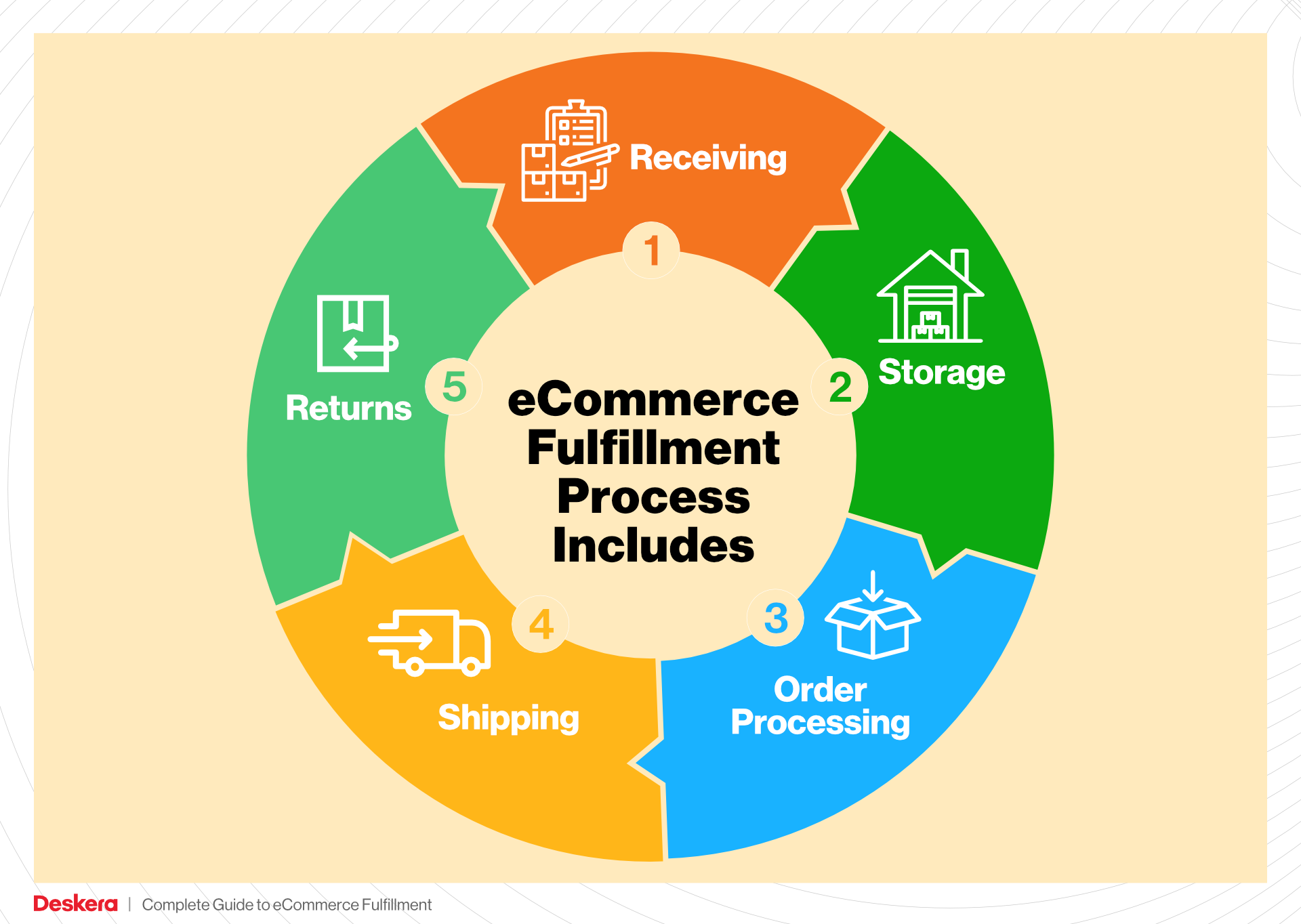
3. Order Picking
Once a customer places an order, the next step is order picking, which involves retrieving items from the warehouse based on the order details. This process often utilizes pick lists—documents that outline the specific items and quantities to be picked. Warehouse staff may use various methods for picking, such as single order picking, batch picking, or wave picking, depending on the order volume and warehouse layout.
Why It’s Important: Efficient order picking directly affects order accuracy and speed. The faster and more accurate the picking process, the quicker the order can be fulfilled, enhancing customer satisfaction and loyalty.
Key Term: Pick List – A document that provides the details of items to be retrieved for customer orders, including SKUs, quantities, and locations within the warehouse.
4. Order Packing
After items are picked, they must be packed for shipping. Packing involves selecting appropriate packing materials and ensuring that products are secured to prevent damage during transit. This step often includes labeling packages with shipping information and barcodes for tracking. Additionally, businesses may implement packaging best practices to enhance the unboxing experience for customers.
Why It’s Important: Proper packing not only protects products but also reduces return rates due to damage. A positive unboxing experience can enhance customer perception of your brand and encourage repeat purchases.
Key Term: Packaging Materials – Items such as boxes, bubble wrap, and packing peanuts used to protect products during shipping.
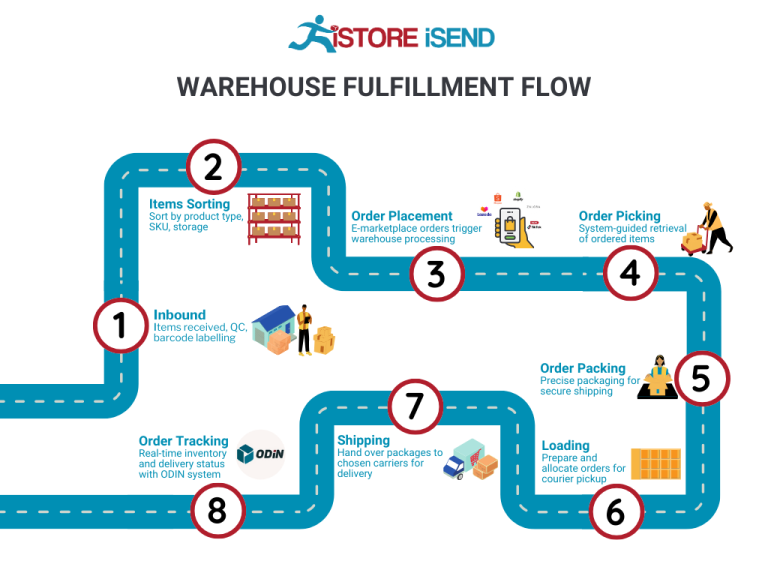
5. Shipping & Delivery
The final step in the order fulfillment process is shipping and delivery. Once orders are packed, they are handed over to shipping carriers who transport them to the customer’s address. It’s crucial to choose reliable shipping partners to ensure timely delivery. Businesses should also provide customers with tracking information, allowing them to monitor their orders in real-time.
Why It’s Important: Timely delivery is a major factor in customer satisfaction. In today’s competitive e-commerce landscape, customers expect swift and reliable shipping. Delays can lead to dissatisfaction and affect future purchasing decisions.
Key Term: Tracking Information – Data provided to customers that allows them to monitor the status and location of their shipment during transit.
By understanding and optimizing each step of the order fulfillment process, e-commerce businesses can enhance operational efficiency, improve customer satisfaction, and ultimately scale their operations effectively. Focusing on these areas will not only streamline your logistics but also create a more fulfilling shopping experience for your customers.
Comparing Fulfillment Models: In-House vs. 3PL vs. Dropshipping
Fulfillment Model Comparison
| Model | Who Handles Inventory | Best For (Business Stage) | Key Advantage | Key Disadvantage |
|---|---|---|---|---|
| In-House Fulfillment | The business itself | Established businesses | Complete control over inventory and fulfillment process | High operational costs and complexity |
| Third-Party Logistics (3PL) | A third-party logistics provider | Growing to large businesses | Scalable, expert logistics management | Less control over inventory and shipping |
| Dropshipping | Suppliers or manufacturers | Startups or small businesses | Low overhead and no inventory risks | Lower profit margins and dependency on suppliers |
In-House Fulfillment
In-house fulfillment refers to managing all aspects of order fulfillment internally, where the business handles its own inventory, warehousing, and shipping. This model is typically suitable for established businesses that have a stable order volume and can afford the overhead costs associated with maintaining a warehouse and logistics team. The key advantage of in-house fulfillment is the complete control it provides over inventory management, order processing, and customer experience. Businesses can customize their fulfillment processes to align closely with their brand values and customer expectations. However, this model also comes with significant disadvantages, such as high operational costs, complexities related to managing logistics, and the need for ongoing investment in technology and infrastructure. Furthermore, as demand fluctuates, businesses may struggle with excess inventory or capacity constraints, impacting overall efficiency and profitability.
Third-Party Logistics (3PL)
Third-party logistics, or 3PL, involves outsourcing logistics and fulfillment operations to specialized providers. This model is ideal for businesses that are growing and require scalable solutions without the burden of managing logistics internally. 3PL providers offer expertise in areas such as warehousing, inventory management, and shipping, allowing businesses to focus on core activities such as marketing and sales. One of the main advantages of using a 3PL is the ability to scale operations quickly in response to market demand without the need for heavy investment in infrastructure. Additionally, 3PLs often have established relationships with carriers and can negotiate better shipping rates, benefiting the business financially. However, the downside is that businesses may have less control over their inventory and shipping processes, which can lead to potential issues with customer satisfaction if the 3PL provider does not meet expectations. Additionally, businesses must ensure they select a reliable 3PL partner, as poor service can negatively impact their reputation.
Dropshipping
Dropshipping is a fulfillment model where the business sells products it does not physically hold in inventory. Instead, when an order is placed, the business purchases the item from a third-party supplier who then ships it directly to the customer. This model is particularly attractive for startups and small businesses looking to minimize upfront costs and reduce inventory risks. The primary advantage of dropshipping is the low overhead, as businesses do not need to invest in inventory or warehousing. This allows entrepreneurs to experiment with a wide range of products without the financial burden of unsold stock. However, dropshipping also presents challenges, including lower profit margins due to reliance on suppliers and potential delays in shipping times, which can impact customer satisfaction. Additionally, businesses are dependent on their suppliers for product quality and availability, making it crucial to partner with reliable vendors. As a result, while dropshipping can be a low-risk entry into e-commerce, it requires careful management of supplier relationships and customer expectations to succeed.
In summary, selecting the right fulfillment model is crucial for e-commerce businesses looking to scale. Each model—In-House Fulfillment, Third-Party Logistics (3PL), and Dropshipping—offers distinct advantages and disadvantages that must be carefully weighed against the business’s operational capabilities, growth stage, and customer service goals. Understanding these models will help business owners make informed decisions that align with their long-term strategies and customer satisfaction objectives.
A Deep Dive into Amazon FBA: Pros, Cons, and Who It’s For
Understanding Fulfillment by Amazon (FBA)
Fulfillment by Amazon (FBA) is a service offered by Amazon that enables sellers to store their products in Amazon’s fulfillment centers. Amazon takes care of storage, packaging, shipping, and customer service on behalf of the sellers. This system leverages Amazon’s vast logistics network, allowing sellers to focus on growing their businesses rather than managing the complexities of order fulfillment.
When a customer places an order for a product listed by a seller using FBA, Amazon handles the entire fulfillment process. This includes picking the product from the warehouse, packaging it, shipping it to the customer, and handling returns and customer inquiries. This seamless integration allows sellers to tap into Amazon’s established infrastructure and customer base.
How FBA Works
-
Setup: Sellers create an Amazon Seller account and enroll in the FBA program. They then prepare their products for shipment according to Amazon’s guidelines.
-
Inventory Shipment: Sellers ship their products to Amazon’s fulfillment centers. Amazon may direct sellers to send their inventory to multiple centers to optimize shipping and delivery times.
-
Storage: Once the inventory arrives at the fulfillment center, it is stored until sold. Amazon provides tools for sellers to track inventory levels and manage stock.
-
Order Processing: When a customer orders a product, Amazon picks the item from inventory, packs it, and ships it directly to the customer.
-
Customer Service and Returns: Amazon also manages customer service inquiries and handles returns, providing a hassle-free experience for both sellers and customers.
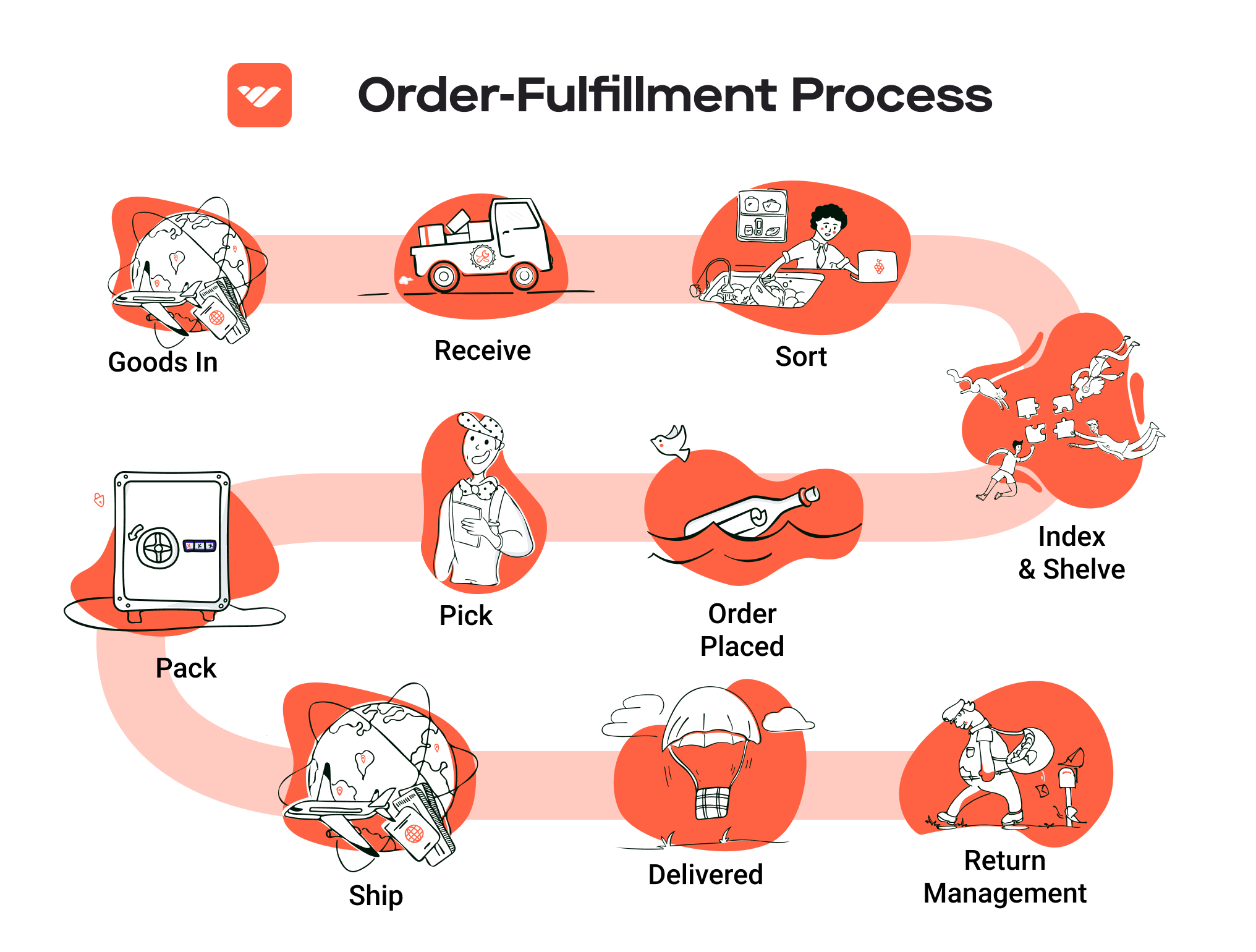
Pros of Using FBA
-
Prime Eligibility: Products fulfilled through FBA are eligible for Amazon Prime, which can significantly increase visibility and sales. Prime members often prefer products with fast shipping options, thus enhancing the likelihood of purchase.
-
Customer Trust: Leveraging Amazon’s trusted platform can lead to increased customer confidence in your products. Customers often feel more secure purchasing from sellers who utilize FBA due to the backing of Amazon’s return policies and customer service.
-
Multi-Channel Fulfillment: FBA allows sellers to fulfill orders from other sales channels (like eBay or their own websites) using Amazon’s logistics. This means you can centralize your fulfillment process while still reaching customers across different platforms.
-
Scalability: FBA can accommodate growing businesses by allowing sellers to scale their operations without the need for significant investment in warehousing or logistics infrastructure.
-
Time-Saving: By outsourcing the fulfillment process, sellers can focus on other critical areas of their business, such as product development, marketing, and customer engagement.
Cons of Using FBA
-
High Fees: FBA services come with various fees, including storage fees for inventory and fulfillment fees per item sold. These costs can add up quickly, especially for low-margin products.
-
Strict Inventory Management Rules: Amazon has stringent policies regarding inventory management, including limits on the number of items that can be stored and requirements for product labeling. Failing to adhere to these rules can result in additional fees or suspension from the program.
-
Commingling Risks: FBA uses a commingled inventory system, meaning that your products may be stored alongside those from other sellers. This can lead to challenges if customers receive the wrong item or if there are quality control issues with other sellers’ products.
-
Dependency on Amazon: Relying heavily on Amazon’s platform can be risky. Changes in Amazon’s policies, fees, or algorithms can significantly impact your business. Additionally, if Amazon were to suspend your account, it could take time to resolve, affecting sales.
-
Less Control Over Branding: When using FBA, the shipping label on packages shows Amazon as the sender, which can dilute your brand’s visibility. Sellers have limited control over packaging and presentation.
Who is FBA Best For?
FBA is particularly beneficial for:
-
Small to Medium-Sized Businesses: Businesses without the resources to manage their logistics and fulfillment processes can greatly benefit from FBA’s infrastructure.
-
Entrepreneurs Looking to Scale: If you aim to grow your business and reach a larger audience quickly, FBA provides the tools and resources needed for rapid scaling.
-
Sellers with High-Volume Products: If you sell products with a high turnover rate, the benefits of FBA can outweigh the costs, especially when considering the increased visibility and sales from being a Prime eligible seller.
-
E-commerce Brands Expanding Online: For brands already established in physical retail, FBA allows a straightforward entry into the e-commerce space, leveraging Amazon’s reach.
-
Sellers in Niche Markets: If you have unique or niche products that might require dedicated customer service, using FBA can provide the necessary support while you focus on other business aspects.
In conclusion, while FBA offers a robust platform for e-commerce businesses to thrive, it is essential to weigh the pros and cons carefully. Understanding how FBA fits into your overall business strategy is critical for leveraging its capabilities effectively.
Core Services Offered by Fulfillment Centers
Inventory Management & Warehousing
Effective inventory management and warehousing are foundational elements of any fulfillment center’s service offerings. This involves the careful tracking, storage, and organization of products in a way that optimizes space and enhances accessibility. Fulfillment centers utilize advanced inventory management software to monitor stock levels in real-time, ensuring that e-commerce businesses have a clear picture of their inventory status.
Benefits:
1. Reduced Costs: By utilizing a fulfillment center’s warehousing solutions, businesses can save on overhead costs associated with maintaining their own storage facilities. This includes costs for utilities, rent, and staffing.
2. Scalability: As your e-commerce business grows, so does the need for additional inventory space. Fulfillment centers provide flexible warehousing solutions that can easily scale according to demand fluctuations.
3. Improved Accuracy: Automated inventory systems reduce the risk of human error in stock counting and order fulfillment, leading to higher accuracy rates and fewer stockouts or overstocks.
Pick and Pack Services
Pick and pack services refer to the process where items are selected (picked) from the warehouse shelves and then packaged (packed) for shipment to customers. Fulfillment centers employ trained staff and efficient systems to streamline this process, often utilizing barcode scanning technology to ensure accuracy.
Benefits:
1. Speed: With dedicated staff and optimized processes, fulfillment centers can significantly reduce the time it takes to pick and pack orders, which is crucial for meeting customer expectations for fast shipping.
2. Customization: Many fulfillment centers offer customizable packing options, allowing businesses to enhance their branding through personalized packaging, such as branded boxes or inserts, which can improve customer satisfaction and loyalty.
3. Reduced Errors: The use of technology in the pick and pack process minimizes errors in order fulfillment, ensuring that customers receive exactly what they ordered, which helps maintain a positive brand reputation.
Kitting and Assembly
Kitting and assembly services involve grouping various products together to create a new, bundled product that is sold as a single unit. This is particularly useful for businesses that offer subscription boxes or promotional bundles. Fulfillment centers handle the intricate logistics of assembling these kits, ensuring that all components are included and correctly packaged.
Benefits:
1. Enhanced Product Offerings: By offering bundled products, businesses can create unique offerings that attract customers and differentiate them from competitors. This can lead to increased sales and higher average order values.
2. Time Savings: Outsourcing kitting and assembly to fulfillment centers frees up internal resources, allowing businesses to focus on core operations such as marketing and customer service.
3. Quality Control: Fulfillment centers often have stringent quality control measures in place, ensuring that each kit meets the required standards before it is shipped to customers, thereby enhancing customer trust.
Returns Management (Reverse Logistics)
Returns management, or reverse logistics, is a critical service provided by fulfillment centers. This process involves handling product returns efficiently and effectively, including the inspection, restocking, and processing of returned items. Given that returns are a natural part of e-commerce, having a structured returns management system is essential for maintaining customer satisfaction.
Benefits:
1. Improved Customer Experience: A streamlined returns process helps reassure customers that they can return products easily if they are unsatisfied, enhancing overall shopping confidence and encouraging repeat purchases.
2. Cost Efficiency: Fulfillment centers manage returns in a way that minimizes losses for businesses, often refurbishing or restocking items that are still sellable, thereby recapturing potential revenue.
3. Data Insights: By analyzing return trends, fulfillment centers provide valuable insights into product performance and customer preferences, enabling businesses to make informed decisions about inventory and product offerings.
In conclusion, partnering with a fulfillment center can provide e-commerce businesses with a comprehensive suite of services designed to streamline operations, enhance customer satisfaction, and ultimately drive growth. By leveraging the expertise and technology of fulfillment centers, businesses can focus on scaling their sales without the burdens of logistics and inventory management.
How to Choose a Fulfillment Partner: A 6-Point Checklist
Location & Warehouse Network
Importance: The geographical location of your fulfillment partner’s warehouses can significantly affect shipping times and costs. A partner with warehouses located strategically near your target markets can help reduce transit times, improve customer satisfaction, and lower shipping costs.
Questions to Ask:
– Where are your warehouses located, and how do these locations align with our primary customer demographics?
– Do you have multiple warehouses to ensure quicker delivery options?
– How do you handle shipping to international customers, and what partnerships do you have for cross-border logistics?
Technology & Integrations
Importance: In today’s e-commerce landscape, seamless technology integration is crucial. A fulfillment partner should offer robust technology solutions that integrate with your existing systems (like your e-commerce platform, inventory management, and CRM). This ensures real-time inventory tracking, order processing, and accurate data reporting.
Questions to Ask:
– What technology platforms do you use for order management, and how can they integrate with our current systems?
– Do you provide real-time tracking for shipments, and how is this information communicated to both us and our customers?
– Can you provide API access for customized integrations?
Specializations (e.g., Cold Storage, Oversized Items)
Importance: Depending on the nature of your products, you may require a fulfillment partner with specialized capabilities. For instance, if you sell perishable goods, cold storage facilities are essential. Alternatively, if you handle oversized items, make sure the partner has the infrastructure to accommodate them without incurring excessive handling fees.
Questions to Ask:
– What types of products do you specialize in fulfilling, and do you have the necessary facilities (like climate control or specialized handling) for our products?
– Can you manage unique packaging or handling requirements we may have?
– How do you ensure compliance with industry regulations for specialized products?
Scalability & Capacity
Importance: As your business grows, your fulfillment needs will likely change. A good fulfillment partner should be able to scale their services to match your growth, whether that means handling seasonal spikes in demand or expanding your product line.
Questions to Ask:
– How do you manage fluctuations in order volume, especially during peak seasons?
– What is your current capacity for order fulfillment, and how quickly can you scale to meet our needs?
– Can you provide case studies or examples of how you’ve successfully scaled for other clients?
Pricing and Contracts
Importance: Understanding the pricing structure and contract terms of a fulfillment partner is crucial for budgeting and financial planning. Look for transparency in pricing and avoid hidden fees that could impact your margins.
Questions to Ask:
– Can you provide a detailed breakdown of your pricing model, including any additional fees for storage, packing, or shipping?
– What are the contract terms, and is there flexibility in case our needs change?
– Are there minimum order or volume commitments required, and how do those impact pricing?
Customer Support & Reviews
Importance: Reliable customer support is vital for troubleshooting issues that may arise during the fulfillment process. Moreover, reviewing feedback from other clients can provide insight into the partner’s reliability and service quality.
Questions to Ask:
– What kind of customer support do you provide, and how can we reach you in case of urgent issues?
– Can you share testimonials or case studies from other clients, particularly those with similar business models?
– How do you handle order discrepancies or customer complaints, and what is the typical resolution time?
Conclusion
Choosing the right fulfillment partner is a critical decision that can impact your business’s efficiency, customer satisfaction, and ultimately, your bottom line. By using this checklist, you can systematically evaluate potential partners and ensure that they align with your operational needs and business goals. Taking the time to ask the right questions will lead to a more informed decision, setting your business up for success as you scale.
Understanding Fulfillment Pricing: A Breakdown of Common Fees
Initial Setup Fees
When partnering with a fulfillment service, businesses often encounter initial setup fees. These fees cover the costs associated with onboarding your business onto the fulfillment provider’s platform. This can include software integration, inventory system setup, and the initial mapping of your products (SKUs).
The calculation of initial setup fees can vary significantly depending on the complexity of your requirements. Factors influencing these fees include the number of products you have, the need for custom software solutions, and the extent of training required for your team to effectively use the system. Typically, you can expect these fees to range from a few hundred to several thousand dollars, depending on the provider and the specifics of your operation.
Receiving Fees
Receiving fees are charged when your inventory arrives at the fulfillment center. This fee covers the labor and resources needed to inspect, count, and store your products. The receiving process ensures that your products are in good condition and accurately accounted for before they are added to your inventory.
These fees are usually calculated on a per-unit basis or as a flat fee per shipment, depending on the provider. For example, a fulfillment center might charge $0.30 per item received or a flat fee of $50 for each shipment, regardless of the number of items. Understanding how these fees are structured can help you better manage your incoming inventory costs.
Storage Fees (per pallet/bin)
Storage fees are incurred for the space your products occupy within the fulfillment center. These fees can be calculated based on the volume of space your inventory occupies, typically measured in pallets or bins.
Storage fees can vary by provider and may be charged monthly or quarterly. A common model is a monthly fee of $20 to $40 per pallet, or a per-bin fee of $5 to $10. Additionally, some fulfillment centers offer tiered pricing where the cost per pallet decreases as your storage volume increases. It’s crucial to accurately estimate your storage needs to avoid unexpected costs.
Pick & Pack Fees (per item/order)
Pick and pack fees are one of the most common charges in fulfillment pricing. This fee covers the labor involved in retrieving items from storage, packing them for shipment, and preparing them for delivery.
Typically, pick and pack fees are structured as a per-item or per-order charge. For example, a fulfillment center might charge $1.50 per item picked and packed or a flat rate of $3.00 per order, regardless of how many items are included. Understanding how these fees are calculated can help you optimize your product offerings and manage costs effectively, especially if you have a high volume of small orders.
Shipping Fees
Shipping fees are incurred when your products are dispatched to customers. These costs can vary widely based on several factors, including the shipping method chosen (standard, expedited, etc.), the destination, and the size and weight of the package.
Shipping fees can be calculated through various methods, including flat-rate shipping, weight-based pricing, or dimensional weight pricing. Businesses should work closely with their fulfillment partner to understand how shipping costs are calculated and explore options that could reduce expenses, such as negotiated rates with carriers or implementing a tiered shipping strategy based on order value.
Tips for Getting an Accurate Quote
-
Detailed Inventory List: Provide a comprehensive list of your products, including dimensions, weights, and quantities. This information is crucial for accurate pricing.
-
Understand Your Needs: Clearly outline your fulfillment needs, including storage requirements, order volume, and shipping preferences. This helps providers give you a tailored quote.
-
Ask About Hidden Fees: Inquire about any potential hidden fees that may not be immediately apparent, such as returns processing or seasonal storage fees.
-
Compare Multiple Providers: Don’t settle for the first quote. Compare offers from multiple fulfillment services to ensure you’re getting the best value for your specific needs.
-
Negotiate: Many fulfillment providers are open to negotiation, especially if you can demonstrate a high volume of orders or a long-term partnership potential.
By understanding these common fulfillment pricing models and following these tips, e-commerce businesses can make informed decisions that align with their operational goals and budget constraints.
Frequently Asked Questions (FAQs) about Fulfillment
1. What is wish fulfillment theory in e-commerce?
Wish fulfillment theory in e-commerce refers to the concept of aligning customer desires and expectations with the fulfillment process. It emphasizes creating a seamless shopping experience that caters to customers’ “wishes,” enhancing satisfaction and driving repeat business. This involves understanding customer preferences and ensuring timely and accurate order delivery.
2. How does wish fulfillment impact customer satisfaction?
Effective wish fulfillment directly correlates with customer satisfaction. When businesses meet or exceed customer expectations regarding delivery speed, product availability, and service quality, it fosters trust and loyalty. Satisfied customers are more likely to return and recommend the business to others, driving growth.
3. What’s the difference between a warehouse and a fulfillment center?
A warehouse is primarily a storage facility where goods are kept until needed, while a fulfillment center is designed for processing and shipping orders directly to customers. Fulfillment centers typically offer additional services like inventory management, order picking, packing, and shipping, streamlining the order fulfillment process.
4. What is a 3PL (Third-Party Logistics)?
A 3PL, or third-party logistics provider, is a company that offers outsourced logistics services, including transportation, warehousing, and fulfillment. Utilizing a 3PL allows e-commerce businesses to focus on core activities while benefiting from the expertise and resources of a logistics specialist, ultimately enhancing operational efficiency.
5. How much do fulfillment services cost?
Fulfillment service costs vary based on several factors, including order volume, storage space, shipping methods, and additional services provided. Typically, businesses can expect to pay a combination of per-order fees, monthly storage fees, and shipping costs. It’s advisable to request quotes from multiple providers to find the best fit for your budget and needs.
6. How can I ensure fast and effective fulfillment for my e-commerce business?
To ensure fast and effective fulfillment, consider the following strategies:
– Partner with a reliable 3PL: Choose a provider with a proven track record in speed and efficiency.
– Optimize inventory management: Keep track of stock levels to avoid backorders and stockouts.
– Leverage technology: Use fulfillment software for real-time order tracking and management.
– Streamline processes: Regularly assess and refine your fulfillment processes to eliminate bottlenecks.
7. What role does technology play in fulfillment services?
Technology plays a crucial role in modern fulfillment services by automating processes, improving accuracy, and providing real-time insights into inventory and order status. Systems such as warehouse management software (WMS), order management systems (OMS), and shipping software enhance efficiency, reduce errors, and improve customer experience.
8. How do I choose the right fulfillment partner?
When selecting a fulfillment partner, consider the following factors:
– Experience and expertise: Look for a provider with a strong track record in your industry.
– Scalability: Ensure they can accommodate your business growth.
– Technology integration: Check if their systems can integrate with your e-commerce platform.
– Customer service: Evaluate their responsiveness and support capabilities.
– Pricing structure: Understand their pricing model and any hidden fees.
9. Can I manage fulfillment in-house, and is it cost-effective?
Managing fulfillment in-house is possible, but it may not be cost-effective as your business scales. While it allows for greater control, it often requires significant investment in warehousing, technology, labor, and logistics expertise. Outsourcing to a 3PL can provide cost savings, efficiency, and flexibility, allowing you to focus on growth.
10. What are the best practices for returns management in fulfillment?
Implementing best practices for returns management includes:
– Clear return policy: Clearly communicate your return policy to customers.
– Efficient processing: Streamline the returns process to minimize delays.
– Data analysis: Track return reasons to identify trends and improve product offerings.
– Customer communication: Keep customers informed throughout the return process to enhance their experience.
By understanding these aspects of fulfillment, e-commerce business owners and operations managers can better navigate the complexities of their logistics and enhance overall customer satisfaction.
Conclusion: Is Outsourcing Fulfillment the Right Move for Your Business?
Evaluating the Benefits of Outsourcing Fulfillment
Outsourcing fulfillment can be a transformative decision for e-commerce businesses seeking to scale efficiently and effectively. One of the most significant advantages is time savings; by delegating logistics to a specialized partner, business owners can focus on strategic growth initiatives rather than day-to-day operational challenges. This allows for enhanced productivity and a more robust approach to customer engagement and marketing.
Scalability is another key benefit. As your sales volume increases, a fulfillment partner can adapt quickly, ensuring that order processing and shipping keep pace with demand. This flexibility is critical in today’s fast-moving e-commerce landscape, where consumer expectations for fast delivery and seamless service are at an all-time high. A reliable fulfillment service can manage spikes in demand, seasonal fluctuations, and international expansion without the need for substantial investment in infrastructure.
Moreover, partnering with a fulfillment expert brings in-depth industry knowledge and operational efficiencies that may be hard to replicate in-house. These providers often have established networks, advanced technology, and best practices that can significantly reduce costs and improve delivery times.
However, the effectiveness of outsourcing hinges on choosing the right partner. It’s crucial to evaluate potential fulfillment services based on their track record, transparency, and ability to meet your specific business needs. A misalignment can lead to operational hiccups, dissatisfied customers, and ultimately, hindered growth.
As a strategic next step, we encourage you to audit your current shipping process. Assess whether your in-house logistics are meeting your business objectives and consider if a fulfillment partner could enhance your operational efficiency and customer satisfaction. By making an informed decision, you can position your business for sustainable growth and success in the competitive e-commerce landscape.
Important Disclaimer
⚠️ Important Disclaimer
The information in this guide is for educational purposes. Fulfillment services, pricing, and platform features change frequently. Always conduct your own due diligence and consult with providers directly before making business decisions.
